This package uses data on daily incidence, the serial interval (time between onsets of infectors and infectees) and the reproduction number to simulate plausible epidemic trajectories and project future incidence. It relies on a branching process where daily incidence follows a Poisson process determined by a daily infectiousness, computed as:
$$
\lambda_t = \sum_{s = 1}^{t - 1} R_s y_s w(t - s)
$$
where:
- w() is the probability mass function (PMF) of the serial interval
- ys is the incidence (by date of onset) at time s
- Rs is the effective reproduction number (average number of secondary cases by infected case) at time s
Installing the package
To install the current stable, CRAN version of the package, type:
install.packages("projections")
To benefit from the latest features and bug fixes, install the development, github version of the package using:
devtools::install_github("reconhub/projections")
Note that this requires the package devtools installed.
What does it do?
The main features of the package include:
project: a function generating projections from an existingincidenceobject, a serial interval distribution, and a set of plausible reproduction numbers (R); returns aprojectionsobject; two models are implemented: Poisson, and Negative Binomial; both models can either use a constant distribution for R, or use time-varying distributionsplot/print: plotting and printing methods forprojectionsobjects.summary: summary method forprojectionsobjects, deriving a range of summary statistics for each day of forecastget_dates: accessors forprojectionsobjectscumulate: cumulate predicted incidence over timeas.data.frame: conversion fromprojectionsobjects todata.frame[: subsetting operator forprojectionsobjects, permiting to specify which dates and simulations to retain; uses a syntax similar to matrices, i.e.x[i, j], wherexis theprojectionsobject,ia subset of dates, andja subset of simulationssubset: subset aprojectionsobject by specifying a time windowbuild_projections: build aprojectionsobject from an input matrix and optional datesmerge_projections: merge severalprojectionsobjects into one, putting them on a common time frame; useful to combine runs from different simulations and/or perform model averagingmerge_add_projections: puts severalprojectionson the same time frame, and adds incidences to form a new object; objects having less simulations are recycled to match the largest number of simulations; useful to combine cases simulated from different processes
Resources
Worked example
Simulated Ebola outbreak
In this example, we use the simulated Ebola outbreak ebola_sim_clean from the outbreaks package to illustrate the package’s functionalities. We will:
- first calculate case incidence
- create a serial interval distribution from known mean / standard deviations (e.g. taken from the literature)
- project case incidence
- summarise the resulting projections
- export results as
data.framefor further processing, e.g. making custom plots using ggplot2 - showcase advanced handling of
projectionsobjects (merging/adding projections)
Computing case incidence
Here we use incidence (from the similarly named package) to calculate daily counts of new cases by date of onset:
library(outbreaks) library(incidence) library(ggplot2) linelist <- ebola_sim_clean$linelist i <- incidence(linelist$date_of_onset) plot(i) + theme_bw() # full outbreak
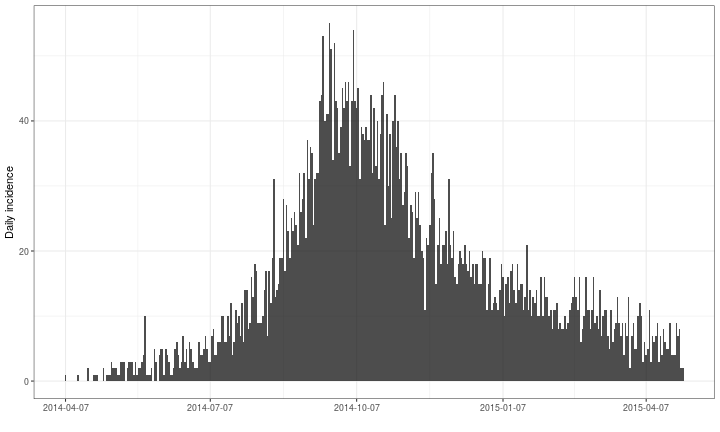
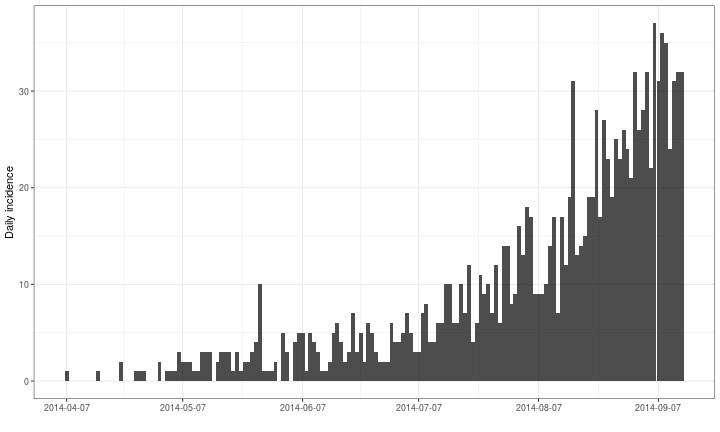
Creating a serial interval
We create a serial interval distribution using distcrete (from the similarly named package); we use published values of the Serial Interval for Ebola with a mean of 15.3 days and a standard deviation of 9.3 days), to build a discretised Gamma distribution. Because the Gamma implementation in R uses shape and scale as parameters, we first need to convert the mean and coefficient of variation into shape and scale, using gamma_mucv2shapescale from the epitrix package.
library(distcrete) library(epitrix) mu <- 15.3 sigma <- 9.3 cv <- sigma / mu params <- gamma_mucv2shapescale(mu, cv) params
## $shape
## [1] 2.706556
##
## $scale
## [1] 5.652941si <- distcrete("gamma", shape = params$shape, scale = params$scale, interval = 1, w = 0.5) si
## A discrete distribution
## name: gamma
## parameters:
## shape: 2.70655567117586
## scale: 5.65294117647059si_df <- data.frame(t = 1:50, p = si$d(1:50)) ggplot(si_df, aes(x = t, y = p)) + theme_bw() + geom_col() + labs(title = "Serial interval", x = "Days after onset", y = "Probability")
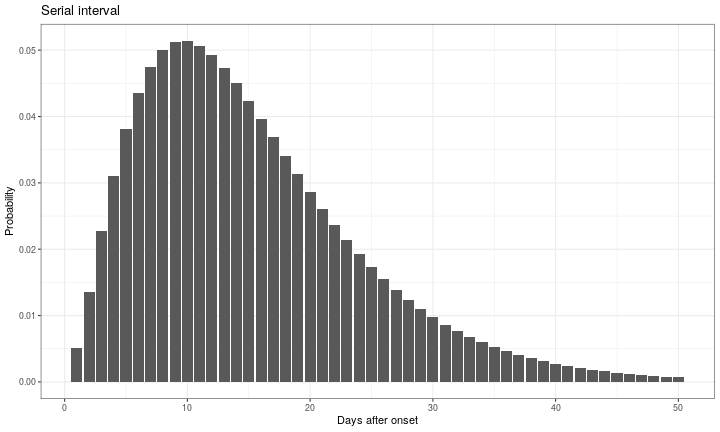
Projecting future incidence
We forecast future incidence based on the incidence data and the serial interval, assuming a reproduction number of 1.5; for the sake of illustration, we start use the first 100 days of data to determine the force of infection, and derive forecasts for 30 days (in practice, forecasts can only be reliable for short term predictions, typically 3 weeks maximum):
library(projections) set.seed(1) pred_1 <- project(i[1:100], R = 1.5, si = si, n_days = 30, n_sim = 1000) pred_1
##
## /// Incidence projections //
##
## // class: projections, matrix
## // 30 dates (rows); 1,000 simulations (columns)
##
## // first rows/columns:
## [,1] [,2] [,3] [,4] [,5] [,6]
## 2014-07-16 4 7 7 7 7 12
## 2014-07-17 9 4 8 10 4 10
## 2014-07-18 8 8 4 3 10 4
## 2014-07-19 8 8 11 6 10 8
## .
## .
## .
##
## // dates:
## [1] "2014-07-16" "2014-07-17" "2014-07-18" "2014-07-19" "2014-07-20"
## [6] "2014-07-21" "2014-07-22" "2014-07-23" "2014-07-24" "2014-07-25"
## [11] "2014-07-26" "2014-07-27" "2014-07-28" "2014-07-29" "2014-07-30"
## [16] "2014-07-31" "2014-08-01" "2014-08-02" "2014-08-03" "2014-08-04"
## [21] "2014-08-05" "2014-08-06" "2014-08-07" "2014-08-08" "2014-08-09"
## [26] "2014-08-10" "2014-08-11" "2014-08-12" "2014-08-13" "2014-08-14"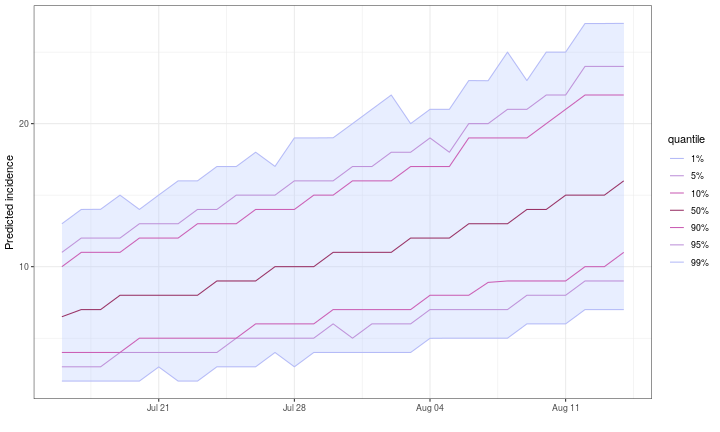
pred_1_cum <- cumulate(pred_1) # cumulative predictions plot(pred_1_cum) + theme_bw() # plot cumulative predictions
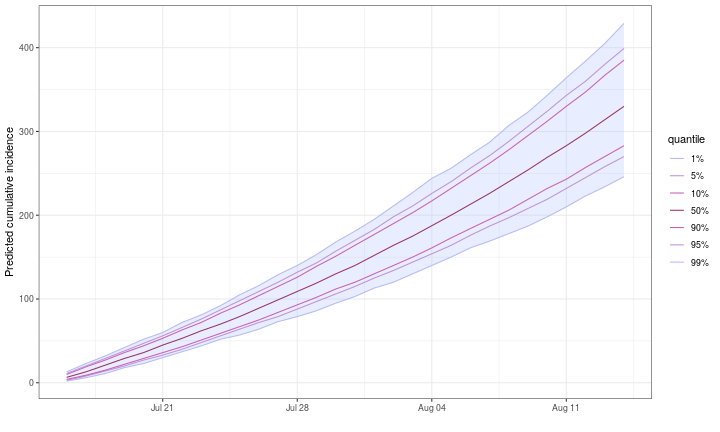
Forecasts stored in a projections object can also be added to an incidence plot using add_projections, which admits the same options as the plot method. This function is best used with a pipe %>%:
library(magrittr) plot(i[20:160], alpha = 0.5) %>% add_projections(pred_1, boxplots = FALSE, quantiles = c(0.025, 0.5)) + theme_bw()
## Scale for 'x' is already present. Adding another scale for 'x', which will
## replace the existing scale.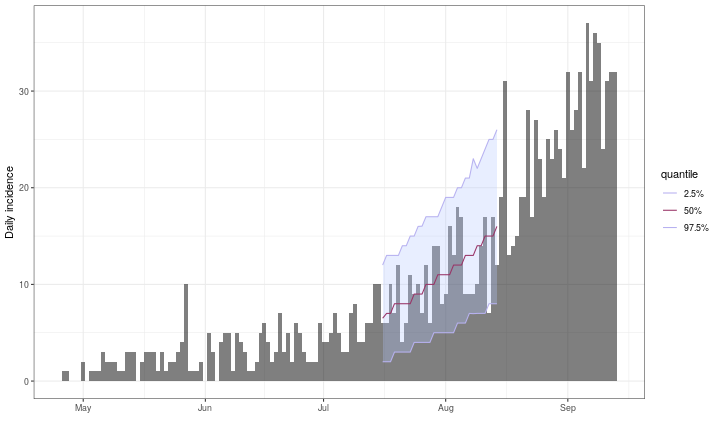
Summarising forecasts
The summary function will summarise simulations using several statistics for each day of the forecast, allowing the user to switch off some of the summaries, and specify quantiles. Several options are illustrated below, but more information will be found at ?summary.projections:
## dates mean sd min max quantiles.2.5% quantiles.25% quantiles.50%
## 1 2014-07-16 6.705 2.580821 1 16 2 5 6.5
## 2 2014-07-17 6.975 2.716202 1 17 2 5 7.0
## 3 2014-07-18 7.313 2.670236 0 17 2 5 7.0
## 4 2014-07-19 7.702 2.712666 0 18 3 6 8.0
## 5 2014-07-20 7.827 2.726996 0 17 3 6 8.0
## 6 2014-07-21 8.221 2.830224 1 18 3 6 8.0
## quantiles.75% quantiles.97.5%
## 1 8 12
## 2 9 13
## 3 9 13
## 4 9 13
## 5 10 13
## 6 10 14## dates mean sd min max quantiles.2.5% quantiles.25%
## 25 2014-08-09 14.020 3.897537 3 28 7 11.00
## 26 2014-08-10 14.525 4.106853 3 28 7 12.00
## 27 2014-08-11 14.900 4.279055 4 32 7 12.00
## 28 2014-08-12 15.693 4.546584 4 33 8 12.75
## 29 2014-08-13 15.821 4.408673 5 36 8 13.00
## 30 2014-08-14 16.339 4.501593 2 33 8 13.00
## quantiles.50% quantiles.75% quantiles.97.5%
## 25 14 16 22
## 26 14 17 23
## 27 15 18 24
## 28 15 19 25
## 29 15 19 25
## 30 16 19 26## dates mean min max
## 1 2014-07-16 6.705 1 16
## 2 2014-07-17 6.975 1 17
## 3 2014-07-18 7.313 0 17
## 4 2014-07-19 7.702 0 18
## 5 2014-07-20 7.827 0 17
## 6 2014-07-21 8.221 1 18## dates mean sd min max quantiles.10% quantiles.50% quantiles.90%
## 1 2014-07-16 6.705 2.580821 1 16 4 6.5 10
## 2 2014-07-17 6.975 2.716202 1 17 4 7.0 11
## 3 2014-07-18 7.313 2.670236 0 17 4 7.0 11
## 4 2014-07-19 7.702 2.712666 0 18 4 8.0 11
## 5 2014-07-20 7.827 2.726996 0 17 5 8.0 12
## 6 2014-07-21 8.221 2.830224 1 18 5 8.0 12To derive your own summary for each day, you can use apply with custom functions; for instance, to calculate the geometric mean for each day:
## function to calculate geometric mean geo_mean = function(x, na.rm = TRUE){ exp(sum(log(x[x > 0]), na.rm = na.rm) / length(x)) } ## raw output apply(pred_1, 1, geo_mean)
## 2014-07-16 2014-07-17 2014-07-18 2014-07-19 2014-07-20 2014-07-21 2014-07-22
## 6.163843 6.392041 6.759438 7.172451 7.295941 7.674789 7.671474
## 2014-07-23 2014-07-24 2014-07-25 2014-07-26 2014-07-27 2014-07-28 2014-07-29
## 8.026384 8.522398 8.618595 8.849186 9.182769 9.602397 9.960910
## 2014-07-30 2014-07-31 2014-08-01 2014-08-02 2014-08-03 2014-08-04 2014-08-05
## 10.244793 10.343175 10.746244 10.945269 11.274515 11.762397 11.945831
## 2014-08-06 2014-08-07 2014-08-08 2014-08-09 2014-08-10 2014-08-11 2014-08-12
## 12.588968 12.623958 12.924687 13.449257 13.900736 14.261928 15.006552
## 2014-08-13 2014-08-14
## 15.194230 15.679589## with some formatting temp <- apply(pred_1, 1, geo_mean) data.frame(date = get_dates(pred_1), geometric_mean = apply(pred_1, 1, geo_mean), row.names = NULL)
## date geometric_mean
## 1 2014-07-16 6.163843
## 2 2014-07-17 6.392041
## 3 2014-07-18 6.759438
## 4 2014-07-19 7.172451
## 5 2014-07-20 7.295941
## 6 2014-07-21 7.674789
## 7 2014-07-22 7.671474
## 8 2014-07-23 8.026384
## 9 2014-07-24 8.522398
## 10 2014-07-25 8.618595
## 11 2014-07-26 8.849186
## 12 2014-07-27 9.182769
## 13 2014-07-28 9.602397
## 14 2014-07-29 9.960910
## 15 2014-07-30 10.244793
## 16 2014-07-31 10.343175
## 17 2014-08-01 10.746244
## 18 2014-08-02 10.945269
## 19 2014-08-03 11.274515
## 20 2014-08-04 11.762397
## 21 2014-08-05 11.945831
## 22 2014-08-06 12.588968
## 23 2014-08-07 12.623958
## 24 2014-08-08 12.924687
## 25 2014-08-09 13.449257
## 26 2014-08-10 13.900736
## 27 2014-08-11 14.261928
## 28 2014-08-12 15.006552
## 29 2014-08-13 15.194230
## 30 2014-08-14 15.679589Exporting results
The function as.data.frame can be handy for further processing of the forecast. The argument long in particular will be handy for further processing using dplyr or ggplot2, as it stores the ‘simulation’ as a 3rd columns, which can be used for grouping and/or aesthetics.
Here is an example with ggplot2 to produce an alternative plot:
df <- as.data.frame(pred_1, long = TRUE) head(df)
## date incidence sim
## 1 2014-07-16 4 1
## 2 2014-07-17 9 1
## 3 2014-07-18 8 1
## 4 2014-07-19 8 1
## 5 2014-07-20 5 1
## 6 2014-07-21 8 1ggplot(df, aes(x = date, y = incidence)) + theme_bw() + geom_jitter(alpha = 0.05, size = 4) + geom_smooth()
## `geom_smooth()` using method = 'gam' and formula 'y ~ s(x, bs = "cs")'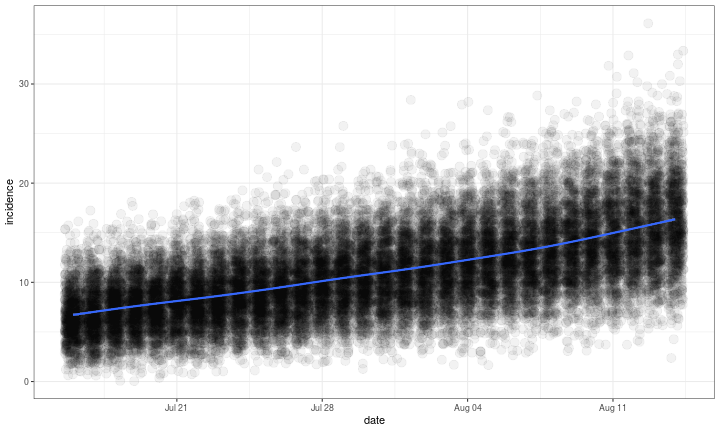
Advanced handling
projections objects can also be combined in two ways:
-
merge different sets of simulations, using
merge_projections; this can be useful e.g. for model averaging, where different models produce separate sets of forecasts which need combining -
add forecasts from different simulation sets, using
+, ormerge_add_projections; this can be useful for simulating cases from different, complementary processes
We illustrate case 1, where we produce a second set of forecasts pred_2 using a different serial interval distribution, which we combine to pred_1. For the sake of example, we use a made-up serial interval which is much shorter than the one used in pred_1, with an average of 4 days, and a standard deviation of 2 days.
mu <- 4 sigma <- 2 cv <- sigma / mu params <- gamma_mucv2shapescale(mu, cv) params
## $shape
## [1] 4
##
## $scale
## [1] 1si_short <- distcrete("gamma", shape = params$shape, scale = params$scale, interval = 1, w = 0.5) si_short
## A discrete distribution
## name: gamma
## parameters:
## shape: 4
## scale: 1si_short_df <- data.frame(t = 1:20, p = si_short$d(1:20)) ggplot(si_short_df, aes(x = t, y = p)) + theme_bw() + geom_col() + labs(title = "Other serial interval", x = "Days after onset", y = "Probability")
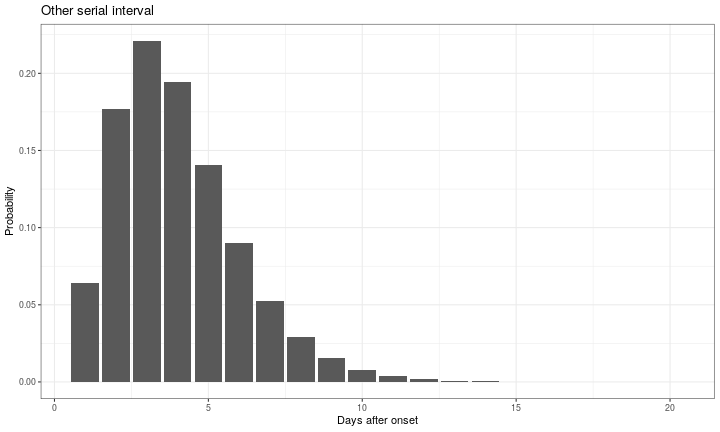
We now use this serial interval to produce a second set of forecasts. We compare them to the initial one, and the combined forecasts:
set.seed(1) pred_2 <- project(i[1:100], R = 1.5, si = si_short, n_days = 30, n_sim = 1000) pred_2 # 1000 simulations
##
## /// Incidence projections //
##
## // class: projections, matrix
## // 30 dates (rows); 1,000 simulations (columns)
##
## // first rows/columns:
## [,1] [,2] [,3] [,4] [,5] [,6]
## 2014-07-16 6 10 11 10 10 16
## 2014-07-17 13 12 7 12 10 12
## 2014-07-18 15 12 12 12 14 15
## 2014-07-19 13 11 20 9 15 16
## .
## .
## .
##
## // dates:
## [1] "2014-07-16" "2014-07-17" "2014-07-18" "2014-07-19" "2014-07-20"
## [6] "2014-07-21" "2014-07-22" "2014-07-23" "2014-07-24" "2014-07-25"
## [11] "2014-07-26" "2014-07-27" "2014-07-28" "2014-07-29" "2014-07-30"
## [16] "2014-07-31" "2014-08-01" "2014-08-02" "2014-08-03" "2014-08-04"
## [21] "2014-08-05" "2014-08-06" "2014-08-07" "2014-08-08" "2014-08-09"
## [26] "2014-08-10" "2014-08-11" "2014-08-12" "2014-08-13" "2014-08-14"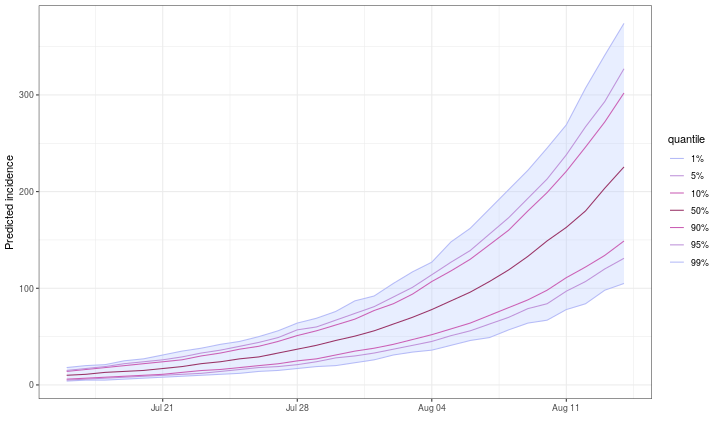
## combine the objects; note that any number of objects can be combined pred_combined <- merge_projections(list(pred_1, pred_2)) pred_combined # 2000 simulations
##
## /// Incidence projections //
##
## // class: projections, matrix
## // 30 dates (rows); 2,000 simulations (columns)
##
## // first rows/columns:
## sim_1 sim_2 sim_3 sim_4 sim_5 sim_6
## 2014-07-16 4 7 7 7 7 12
## 2014-07-17 9 4 8 10 4 10
## 2014-07-18 8 8 4 3 10 4
## 2014-07-19 8 8 11 6 10 8
## .
## .
## .
##
## // dates:
## [1] "2014-07-16" "2014-07-17" "2014-07-18" "2014-07-19" "2014-07-20"
## [6] "2014-07-21" "2014-07-22" "2014-07-23" "2014-07-24" "2014-07-25"
## [11] "2014-07-26" "2014-07-27" "2014-07-28" "2014-07-29" "2014-07-30"
## [16] "2014-07-31" "2014-08-01" "2014-08-02" "2014-08-03" "2014-08-04"
## [21] "2014-08-05" "2014-08-06" "2014-08-07" "2014-08-08" "2014-08-09"
## [26] "2014-08-10" "2014-08-11" "2014-08-12" "2014-08-13" "2014-08-14"list_plots <- list( plot(pred_1) + theme_bw() + labs(title = "Forecast with initial SI"), plot(pred_2,) + theme_bw() + labs(title = "Forecast with short SI"), plot(pred_combined) + theme_bw() + labs(title = "Combined forecasts") ) library(cowplot) plot_grid(plotlist = list_plots, ncol = 1)
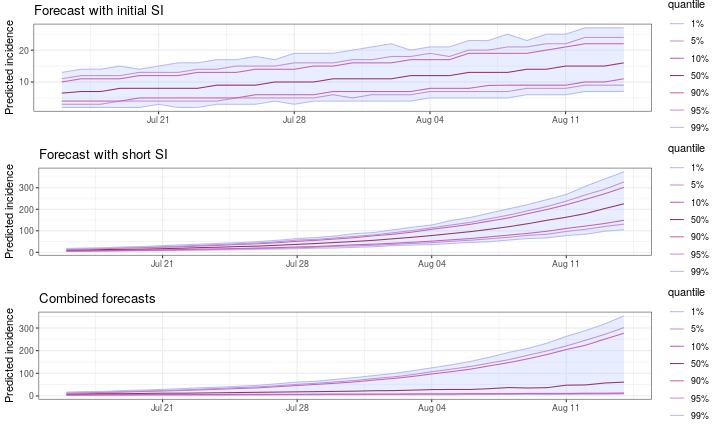
To illustrate case 2 (not only merging, but adding projections objects), we artificially split the dataset by hospitals, derive separate forecasts for each, and add forecasts of two hospitals in the example below.
## calculate incidence by hospital i_hosp <- incidence(linelist$date_of_onset, groups = linelist$hospital) plot(i_hosp) + theme_bw() + theme(legend.position = "bottom")
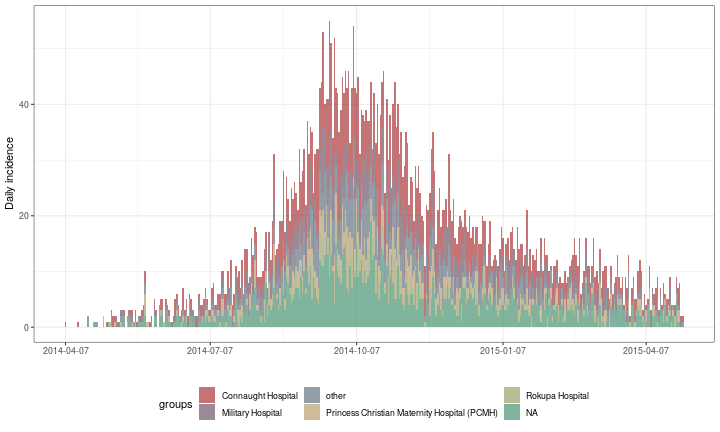
## derive predictions for each hospital n_groups <- ncol(get_counts(i_hosp)) pred_hosp <- lapply( seq_len(n_groups), function(j) project(i_hosp[1:100, j], R = 1.5, si = si, n_days = 60, n_sim = 500)) names(pred_hosp) <- colnames(get_counts(i_hosp)) ## we combine forecasts for Connaught and Rokupa hospitals pred_connaught_rokupa <- pred_hosp$`Connaught Hospital` + pred_hosp$`Rokupa Hospital` list_plots <- list( plot(pred_hosp$`Connaught Hospital`) + theme_bw() + ylim(c(0, 30)) + labs(title = "Connaught hospital"), plot(pred_hosp$`Rokupa Hospital`) + theme_bw() + ylim(c(0, 30)) + labs(title = "Rokupa hospital"), plot(pred_connaught_rokupa) + theme_bw() + ylim(c(0, 30)) + labs(title = "Connaught + Rokupa") ) plot_grid(plotlist = list_plots, ncol = 1)
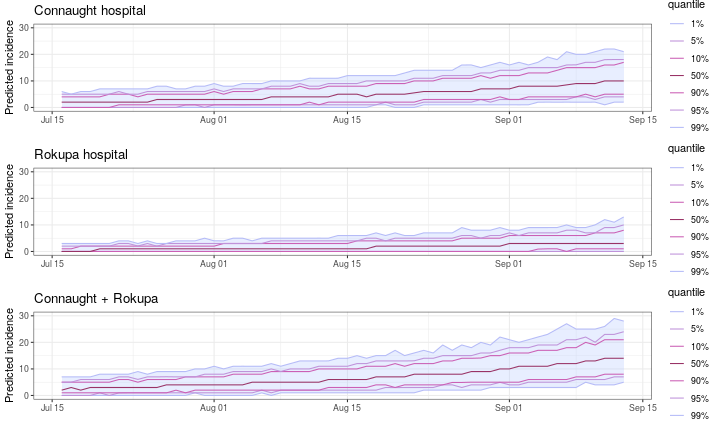
Note that to add more than 2 projections objects, one can use merge_add_projections. Also note that the + operator can also be used with a numeric, e.g. for adding an offset. For instance:
plot(pred_connaught_rokupa + 1000) + theme_bw() + labs(title = "Connaught + Rokupa with 1000 added cases")
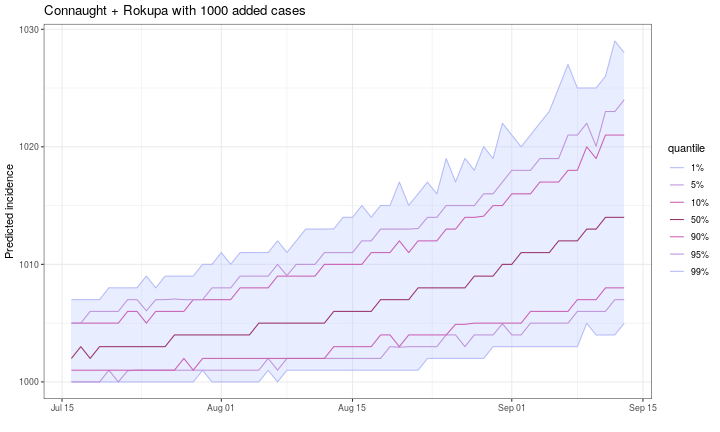
Vignettes
projections does not currently have a dedicated vignette. This README will eventually be converted into separate vignettes.
Websites
A dedicated website can be found at: http://www.repidemicsconsortium.org/projections.
Getting help online
Bug reports and feature requests should be posted on github using the issue system. All other questions should be posted on the RECON forum:
http://www.repidemicsconsortium.org/forum/
Contributions are welcome via pull requests.
Please note that this project is released with a Contributor Code of Conduct. By participating in this project you agree to abide by its terms.